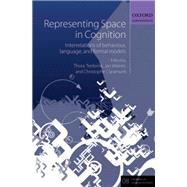Representing Space in Cognition Interrelations of behaviour, language, and formal models
, by Tenbrink, Thora; Wiener, Jan M.; Claramunt, Christophe- ISBN: 9780199679911 | 0199679916
- Cover: Hardcover
- Copyright: 12/31/2013
Thora Tenbrink, Lecturer in Cognitive Linguistics, Bangor University,Jan M. Wiener, Senior Lecturer in Psychology, University of Bournemouth,Christophe Claramunt, Chair of the Naval Academy Research Institute, France
Thora Tenbrink is a Lecturer in Cognitive Linguistics at Bangor University (Wales, UK). She worked for ten years as a research scientist at the Faculty of Linguistics at Bremen University (Germany), and is a principal investigator in two projects in the Collaborative Research Center SFB/TR 8 Spatial Cognition (Bremen/Freiburg). Her main interest concerns the relationship between cognitive processes and linguistic representations. She is the author of Space, Time, and the Use of Language (Mouton de Gruyter, 2007), and editor, with Kenny Coventry and John Bateman, of Spatial Language and Dialogue (OUP, 2009).
Jan Wiener is a Senior Lecturer in Psychology at the University of Bournemouth (UK). Previously he has worked as a research scientist at the University of Freiburg (Germany), the CNRS (Paris, France), and the Max-Planck-Institute for Biological Cybernetics (Tubingen, Germany). His research focuses primarily on the cognitive processes and strategies that underly navigation and wayfinding behaviour.
Christophe Claramunt is a Professor in Computer Science and Chair of the Naval Academy Research Institute in France. He was previously a Senior Lecturer in Computing at the Nottingham Trent University and a Senior Researcher at the Swiss Federal Institute of Technology in Lausanne. He holds a PhD in Computer Science from the University de Bourgogne in France. His main research interests concern theoretical and multi-disciplinary aspects of geographical information science, including spatio-temporal and computational models, alternative models of space, semantic GIS, integration of GIS and simulation systems, and the spatial Web.
1. Introduction, Thora Tenbrink, Jan Wiener, and Christophe Claramunt
Part I: Empirical Insights
2. Describing the Way Out of a Cornfield: Understanding congitive underpinnings of comprehending survey and route descriptions, Holly Taylor and Tad T. Brunye
3. Spatial Representations for Described and Perceived Locations, Marios Avraamides, Catherine Mello, and Nathan Greenauer
4. The Processing of Landmarks in Route Directions, Michel Denis and Gilles Fernandez
Part II: Computational Models
5. Selection of Reference Objectives for Locative Expressions: The importance of knowledge and perception, Michael Barclay and Antony Galton
6. Spatial prototypes, Eric Chown
7. Learning to Interpret Spatial Natural Language in Terms of Qualitative Spatial Relations, Parisa Kordjamshidi, Joana Hois, Martijn van Otterlo, and Marie-Francine Moens
Part III: Intuitive Assistance
8. Cognitive Operations in Tour Planning, Inessa Seifert and Thora Tenbrink
9. Navigation Assistance for Blind Pedestrians: Guidelines for the design of devices and implications for spatial cognition, mathieu Gallay, Michel Denis, and Malika Auvray
10. A Computational Model of Cooperative Spatial Behaviour for Virtual Humans, Nhung Nguyen and Ipke Wachsmuth
11. The 'Space' in Spatial Assistance Systems: Conception, formalisation, and computation, Mehul Bhatt, Carl Schultz, and Christian Freksa
The New copy of this book will include any supplemental materials advertised. Please check the title of the book to determine if it should include any access cards, study guides, lab manuals, CDs, etc.
The Used, Rental and eBook copies of this book are not guaranteed to include any supplemental materials. Typically, only the book itself is included. This is true even if the title states it includes any access cards, study guides, lab manuals, CDs, etc.
Digital License
You are licensing a digital product for a set duration. Durations are set forth in the product description, with "Lifetime" typically meaning five (5) years of online access and permanent download to a supported device. All licenses are non-transferable.
More details can be found here.






